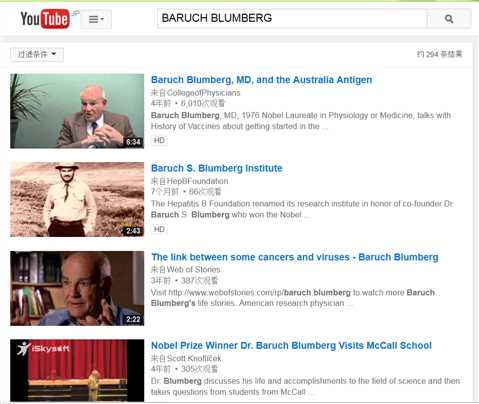标签:
From Wikipedia, the free encyclopedia
| Baruch Samuel Blumberg | |
|---|---|
 |
|
| Born | July 28, 1925 Brooklyn, New York, U.S. |
| Died | April 5, 2011 (aged 85) Mountain View, California, U.S. |
| Nationality | American |
| Fields | Biochemistry, Physiology |
| Institutions | Fox Chase Cancer Center University of Pennsylvania NASA Astrobiology Institute |
| Alma mater | Union College Balliol College, Oxford College of Physicians and Surgeons |
| Known for | Hepatitis B virus |
| Notable awards | Nobel Prize in Medicine (1976) |
| Spouse | Jean Liebesman (m. 1954) |
| Children | Jane, Anne, George and Noah |
|
Notes
[1] |
|
YouTube视频资源

Baruch Samuel Blumberg (July 28, 1925 – April 5, 2011) — known as Barry Blumberg — was an American physician, geneticist, and co-recipient of the 1976 Nobel Prize in Physiology or Medicine (with Daniel Carleton Gajdusek) for his work on the hepatitis B virus while an investigator at the NIH.[2] He was President of the American Philosophical Society from 2005 until his death.
Blumberg received the Nobel Prize for "discoveries concerning new mechanisms for the origin and dissemination of infectious diseases." Blumberg identified the hepatitis B virus and later developed its diagnostic test and vaccine.[2][3]
Blumberg was born in Brooklyn, New York, the son of Ida (Simonoff) and Meyer Blumberg, a lawyer.[4][5] He first attended the Orthodox Yeshivah of Flatbush for elementary school, where he learned to read and write in Hebrew and to study the Bible and Jewish texts in their original language. (That school also had among its students a contemporary of Blumberg, Eric Kandel, who is another recipient of the Nobel Prize in medicine.) Blumberg then attended Far Rockaway High School in the early 1940s, a school that also produced fellow laureates Burton Richter and Richard Feynman.[6] Blumberg served as a U.S. Navy deck officer during World War II.[2] He then attended Union College in Schenectady, New York and graduated from there with honors in 1946.[7]
Originally entering the graduate program in mathematics at Columbia University, Blumberg switched to medicine and enrolled at Columbia‘s College of Physicians and Surgeons, from which he received his M.D. in 1951. He remained at Columbia Presbyterian Medical Center for the next four years, first as an intern and then as a resident. He then began graduate work in biochemistry at Balliol College, Oxford and earned his Ph.D there in 1957 as well as eventually being the first American to be master there.[8]
Throughout the 1950s, Blumberg traveled the world taking human blood samples and studying the inherited variations in human beings, focusing on why some people contracted diseases in similar environments that others did not. In 1964, while studying yellow jaundice, he discovered a surface antigen for hepatitis B in the blood of an Australian aborigine.[9] Blumberg and his team were able to develop a screening test for the virus to prevent its spread in blood donations and developed a vaccine. Blumberg later freely distributed his vaccine patent in order to promote its fielding by drug companies. Deployment of the vaccine reduced the infection rate of hepatitis B in children in China from 15% to 1% in 10 years.[10]
Blumberg became a member of the Fox Chase Cancer Center in Philadelphia in 1964, and held the rank of University Professor of Medicine and Anthropology at the University of Pennsylvania starting in 1977. Concurrently, he was Master of Balliol College from 1989 to 1994. He was elected a Fellow of the American Academy of Arts and Sciences in 1994.[11] From 1999 to 2002, he was also director of the NASA Astrobiology Institute at the Ames Research Center in Moffett Field, California.[12][13][14]
In November 2004, Blumberg was named Chairman of the Scientific Advisory Board of United Therapeutics Corporation,[15] a position he held until his death. As Chairman he convened three Conferences on Nanomedical and Telemedical Technology,[16] as well as guiding the biotechnology company into the development of a broad-spectrum anti-viral medicine.
Beginning in 2005, Blumberg also served as the President of the American Philosophical Society. He had been first elected to membership in the society in 1986.[17]
In October 2010 Blumberg participated in the USA Science and Engineering Festival‘s Lunch with a Laureate program whereby middle and high school students of the Greater Washington D.C., Northern Virginia and Maryland area get to engage in an informal conversation with a Nobel Prize–winning scientist over a brown-bag lunch.[18] Blumberg came to General George A. McCall Elementary on Sept. 29, 2010 as part of the program.
In an interview with the New York Times in 2002 he stated that "[Saving lives] is what drew me to medicine. There is, in Jewish thought, this idea that if you save a single life, you save the whole world".[19]
In discussing the factors that influenced his life, Blumberg always gave credit to the mental discipline of the Jewish Talmud, and as often as possible he attended weekly Talmud discussion classes until his death.[20]
Blumberg died on April 5, 2011,[1] shortly after giving the keynote speech at the International Lunar Research Park Exploratory Workshop held at NASA Ames Research Center.[21] At the time of his death Blumberg was a Distinguished Scientist at the NASA Lunar Science Institute, located at the NASA Ames Research Center in Moffett Field, California.[22][23]
Jonathan Chernoff, the scientific director at the Fox Chase Cancer Center where Blumberg spent most of his working life said, "I think it’s fair to say that Barry prevented more cancer deaths than any person who’s ever lived."[24] In reference to Blumberg‘s discovery of the Hepatitis B vaccine, former NASA administrator Daniel Goldin said, "Our planet is an improved place as a result of Barry‘s few short days in residence."[25]
His funeral was held on April 10, 2011 at Society Hill Synagogue, where he was a longtime member.[citation needed] The eulogy was delivered by his son-in-law Mark Thompson, the Director-General of the BBC.[26][27]
HBV(24)_Baruch Samuel Blumberg
标签:
原文地址:http://www.cnblogs.com/biopy/p/4345363.html